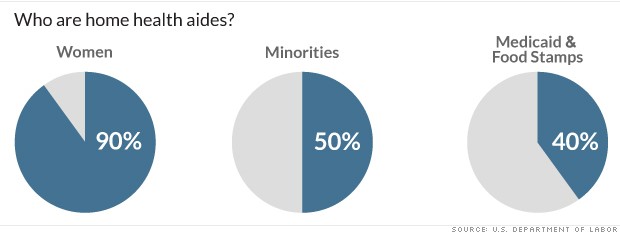Search News
These nearly 2 million (mostly minorities and women) workers do everything from prepare meals and clean homes, to bathe and change bedpans for elderly and disabled patients.
As Baby Boomers age, this job is expected to explode, growing 70% between 2010 and 2020, according to the Labor Department. That makes it the single fastest growing job in the United States, according to their forecasts.
Call it the silver tsunami. Roughly every eight seconds, a Baby Boomer turns 65. And that has led to surging demand for in-home care.
"This isn't just a surge, a one-time hiring spurt. This is something we will do this year and into the future," said Paul Hogan, chairman of Home Instead Senior Care, which alone plans to hire 45,000 caregivers in North America this year. "It's all driven by the growth in the senior population."

But even though there are plenty of job opportunities, many of these people make the same wage as teenagers flipping burgers or selling clothes at the mall. The average hourly wage is just $9.70 an hour, according to the Labor Department.
For those in the industry who work full-time, this amounts to roughly $20,000 a year. Many health care aides only work part-time though -- and they do not receive benefits.
Related: Why Grandma's aide earns so little
Under these conditions, it's no surprise then that about 40% of home aides rely on public assistance, such as Medicaid and food stamps, just to get by.
"What you have is a situation here where the people that we count on to care for our families cannot take care of their own, and that's got to change," said Ai-jen Poo, director of the National Domestic Workers Alliance.
How did this happen?
Many home health care aides are exempt from federal minimum wage and overtime laws, due to a little-known provision in the Fair Labor Standards Act passed in 1974, which puts them in the same category as casual babysitters. The Obama administration has been trying to change that over the past two years, but its efforts have been met fiercely with lobbying from the industry.
While some states have since passed greater protections for home aides, a survey by the National Domestic Workers Alliance shows roughly a quarter of these workers still make less than the federal minimum wage.

Mary Headlam, 63, is a Jamaican immigrant who takes care of 98-year-old Seymour. She lives in his home in Tenafly, N.J. and earns about $750 for working seven days a week. It's not much, but she finds her work now far more fulfilling than her previous job working in a department store.
"The job is rewarding. It gives you the opportunity to work with people who cannot take care of themselves," she said. When asked her about her wages, she said she's comfortable and thankful for the place to live.
Related: Stressful jobs that pay badly
Like Headlam, the majority of home health care aides are minorities and women, and many are foreign born.
A recent study by the Institute for Women's Policy Research estimates immigrants make up 28% of home health care workers, and of those, one in five are undocumented.
The Census Bureau has found that 53% of home health aides are minorities. By their calculations, it is the single most common job for black women, who alone represent nearly a third of the entire profession.
This is part of the reason workers are undervalued and underpaid, say worker advocates like Eileen Boris, a professor of feminist studies at the University of California, Santa Barbara.
"Caring for people is not the same as flipping hamburgers, and the fact that as an economy we value them the same, I think is a testimony to the devaluing of work associated with women, intimacy and the historical association of caring for people with slavery," she said. Boris is the co-author of the book Caring for America: Home Health Workers in the Shadow of the Welfare State.
Related: Men in female-dominated jobs
Many of these workers are also not as educated -- often with no more than a high school diploma. So it would make sense that these workers have far less bargaining power against the large associations and companies lobbying against a change.
The industry does face other price pressures which keep wages low.
Keeping the cost of home care affordable for the elderly is key. Medicare and Medicaid funding cuts due to healthcare reform as well as state budget constraints are also a factor.
"There is a delicate balance between how much seniors and their families can afford -- because they have limited resources -- and how much is appropriate to pay a caregiver," Home Instead Senior Care's Hogan said.
The industry argues that if they're forced to pay minimum wage and overtime, they'll have to restrict workers' hours to 40 hours a week or less. That could actually lead to a reduction in pay for live-in workers. They also fiercely dispute the government's claim that it would only cost an extra $166 per worker a year to comply with federal minimum wage and overtime regulations.
"It's going to increase costs, and it's going to make things more difficult at all levels," said Val Halamandaris, president of the National Association for Home Care & Hospice. "A lot of these individuals could end up losing these jobs."
- CNNMoney video producer Jordan Malter and CNN correspondent Zain Asher contributed to this report. ![]()